Insect & Disease Conditions Update
A printer-friendly version of this report is available on-line from the Conditions Report Index.
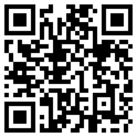 The new Invasive Species Portal on Maine.gov gives citizens easy access to invasive species-related work of state agencies. The portal can help you find resources about destructive flora and fauna that have invaded our state or could be coming very soon. You can access the resource at www.maine.gov/invasives or scan the QR code on the left. If you check out the site and navigate to the DACF MFS page, you’ll find a new entry on oak wilt disease, a devastating disease of oaks that has been found as close as New York State. We count our readers as an important part of our forest health monitoring network; you are a vital to early detection of invaders in our forest and community trees.
|
Laboratory Business Hours are 7:30 a.m. to 4:00 p.m., Monday through Friday, except for holidays.
However, due to a very busy field schedule, we may not be able to staff the Insect and Disease Lab at all times. If you call our Lab and receive no answer, please call back another time.
If you have questions on insect and disease pests of trees, you can submit a clinic form directly on-line at http://maine.gov/dacf/mfs/forest_health/tree_ailment.html. We will also accept samples mailed to our Lab in Augusta. Our street address and location remains the same (50 Hospital Street, Augusta); our mailing address is 168 State House Station, Augusta, 04333-0168.
Allison Kanoti is at the Old Town Regional Office: Phone (207) 827-1813; Fax (207) 827-8441. Mailing Address: MFS, PO Box 415, Old Town, ME 04468; Physical address: 87 Airport Road.
If you plan to visit either office, you may wish to call ahead just to make sure someone will be present to meet with you.
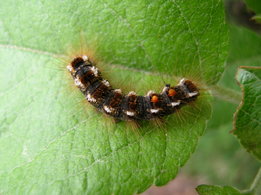 Browntail Moth (Euproctis chrysorrhoea) - Browntail moth caterpillars are feeding voraciously in coastal Maine and inland. The infestation is once again centered in Sagadahoc and northern Cumberland Counties but infested trees can be found from Biddeford (York County) inland to Turner (Androscoggin County) and Waterville (Kennebec County) and has spread as far as Deer Isle (Hancock County).
Photo: Browntail moth Caterpillar (Maine Forest Service).
Like last year, the caterpillars are already stripping the oak and apple leaves off the trees in heavily infested areas and crawling across lawns, houses and cars to get to more food. The frequent rainfall this spring has not led to a fungal epizootic (an event where many caterpillars are infected by a fungus leading to population collapse), so plan on dealing with the hairs from the caterpillars once again this year.
Remember: Timing of pesticide treatment is critical. Treatment before the end of May will reduce the development of the toxic hairs, treatment after the end of May will not provide significant relief.
Licensed Pesticide Applicators may not be able to take any more browntail clients this year as there is so much demand for treatment. If you decide to treat for browntail yourself, consider if you can actually get pesticide to the caterpillars. For your own protection and that of the environment, apply pesticides only in strict accordance with label directions and precautions. Special restrictions apply to treatments near marine waters.
The hairs from this caterpillar can cause a rash or respiratory distress in sensitive individuals. The hairs break off from the skins shed by the caterpillars. The hairs then blow in the wind or are stirred up by mowing, weed wacking, raking, etc. Use caution when working outdoors in infested areas.
The following precautions may help people living or visiting browntail moth infested areas during June through August:
-
Avoid places heavily infested by caterpillars.
- Take a cool shower and change clothes after any activity that might involve contact with browntail moth hairs.
- Dry laundry inside during June and July to avoid having the hairs become impregnated in clothing.
-
Wear a respirator, goggles and coveralls tightly closed at the neck, wrists and ankles when performing activities that stir up caterpillar hairs such as: mowing, raking, weed whacking, removing pupal webbing from eaves and boats.
- Perform the above tasks on damp days or wet down material with a hose as moisture helps keep the hairs from becoming airborne thereby minimizing contact.
- Use caution cleaning debris left by caterpillars because the toxin is extremely stable and remains a hazard for a number of years. Summer residents should bear this in mind when opening cottages that have been closed all winter, as the hairs frequently settle over the winter and may be contacted during spring cleaning activities. Wet mopping prior to vacuuming or dusting is advised.
-
Consult your physician if you develop a severe reaction to the browntail moth.
-
Be aware that the chances of contacting browntail hairs increases during dry, windy conditions.
|
 |
|
Eastern Ash Bark Beetle (Hylesinus aculeatus) – Blonding on ash trees resulting from eastern ash bark beetle was observed in Dexter (Penobscot County). “Blonding” is the term used to describe the appearance of bark on ash trees after woodpeckers and other birds have excavated larvae from beneath the bark. It can be associated with damage from birds going after emerald ash borer, or seeking out bark beetles and woodborers that are native to Maine. We appreciate reports of blonding, and are happy to follow-up to help rule out emerald ash borer damage.
Photo: Eastern ash bark beetle galleries. These galleries were revealed using a drawknife to remove the outer bark from an area with blonding (Credit: ME Project Canopy).
|
Eastern Tent Caterpillar (Malacosoma americana) – The webs of eastern tent caterpillar are quite abundant this year, with many cherries and apples supporting numerous webs. These webs usually originate in branch junctions. They will be full of the frass of well-fed caterpillars and often the caterpillars themselves. If the webs are an aesthetic problem, the best way to manage them is to wind them around a forked stick in the cool hours of the morning or evening, thereby ensnaring the occupants. You can relocate the webs to another host tree out of sight (they do feed generalist predators and other beneficial insects), soak them in a bucket of soapy water or dispose of them in a sealed plastic bag. Be cautious in browntail territory not to confuse the webs of the two species and also because you will sometimes find browntail moth caterpillars snuggled in with their cousins in the safe haven of the eastern tent webs. To see images of the most common hairy tree pest caterpillars of Maine, see the chart below.
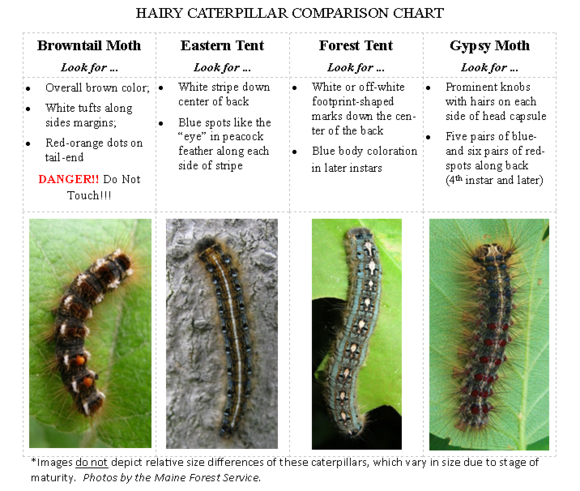
Emerald Ash Borer (Agrilus planipennis) – All trap trees girdled in the spring of 2016 have been peeled and examined for signs of emerald ash borer (EAB). Fortunately, no EAB were found. We are starting to girdle trees again this year to continue monitoring. If you have an ash tree of any species over four inches diameter at 4.5 feet that you would be willing to sacrifice as a trap tree, please email Colleen Teerling with the subject line ‘Trap Tree’ and we will help you create a trap tree. This is one of the most proactive things you as an individual or community can do to monitor for EAB in your area.
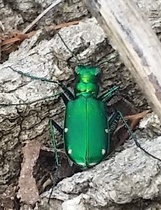
This time of year the native six-spotted tiger beetle adult is very common and highly visible across the state. These blocky, long-legged, metallic green beetles are often mistaken for EAB. Adult EAB have not emerged yet here. In Maine, EAB would emerge in early to mid-June, or when the black locust bloom.
Photo: The native, beneficial six-spotted tiger beetle, Cicindela sexguttata (Credit: Deven Morrill).
|
Hemlock Woolly Adelgid (Adelges tsugae) – Crawlers (the very tiny, mobile young stage of HWA) have emerged. Eggs and/or crawlers are more or less continuously present until late-July or early August. These life-stages can be spread on items other than the host trees (clothing, equipment, pets, etc.).
As a reminder, HWA is a quarantined pest. All products may move freely within the quarantined area. Roundwood products such as logs and pulp may be moved freely within Maine, but must be free from branches. Material with branches, such as chips, moved outside the quarantine area must go to facilities with agreements to receive the material. Quarantine regulations are slightly different in neighboring New Hampshire and Vermont.
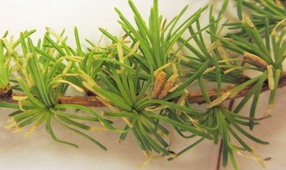 Larch Casebearer (Coleophora laricella) – Spotty and light larch casebearer damage was observed through Penobscot and Southern Aroostook County. Foliage of affected trees has a brown hue; on close examination mined needles, with tan tips are apparent. On samples from T9 R5 WELS (Aroostook County) early spring feeding had finished and pupae had not yet been vacated.
Photo: Larch casebearer feeding damage and cases. At this time, in southern Aroostook County, caterpillars have pupated within the cases and adults have not yet emerged (Maine Forest Service).
|
 Pine Leaf Adelgid (Pineus pinifoliae) – The native Pine leaf adelgid is in epidemic mode in at least north-central Maine (Northern Piscataquis and Penobscot Counties, Southern Aroostook County). Samples of eastern white pine from T9 R5 WELS (Aroostook County) showed signs of a history of damage by pine leaf adelgid including shortened needles and distorted shoots. Close examination of the twig revealed that some nymphs that had settled on the 2016 twigs (exules) have resumed development and molted this spring. No significant reddening of 2016 growth was observed on this date (5/23), but it is expected that affected white pine will begin to flag in the coming weeks. Reports of damage are appreciated (e-mail to Allison Kanoti or call (207) 827-1813).
Photos: Pine leaf adelgid exules that settled in 2016 that has not molted (white arrow) and one that has (black arrow). Keel-shaped cast skins of overwintering stages were apparent on the recently molted nymphs. Most will develop into winged adults that will migrate to red or black spruce (Sexuparae) a smaller proportion will develop into a second generation on pine (Exules) (Photo C. Armstrong, UMaine Extension). This year we expect to see significant damage to 2016 white pine growth in the affected region and appreciate readers’ reports of damage (photo at right from 2015, J. Bissell Baxter State Park).
|
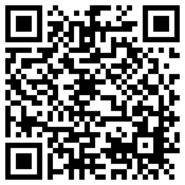 Spruce budworm (Choristoneura fumiferana) – The season for monitoring spruce budworm moths is near and a sincere thank you is due to our cooperators in that effort. This year, 23 different organizations have committed their resources to participating in the Maine Forest Service cooperative pheromone trap network in the area of concern. If all goes as planned, around 450 sites will be set up with 3 traps a piece before the end of next month. This cooperative effort is focused on the larger landowners and managers in affected towns. Cooperators who would like to access on-line directions for trapping and other information relevant to this effort can do so by scanning the QR code to the right (link to MFS spruce budworm webpage).
A separate network of trappers, the budworm trackers, is also gearing up for the trapping season. This network of citizen scientists is coordinated by the Healthy Forest Partnership based out of Canada. Between returning volunteers and new recruits, they are all set for the 2017 trapping season. However, stay tuned to their Facebook page (@budwormtracker on Facebook) for informative videos and other information on spruce budworm in the region.
|
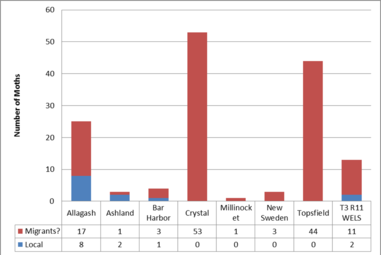 |
|
Finally, data from our light trap operators contribute to our understanding of the geography and timing of budworm moth activity in Maine. For instance, last year an overwhelming proportion of moths caught in light traps coincided with the highly publicized, late-July mass migration of moths from Quebec (see graph on left).
|
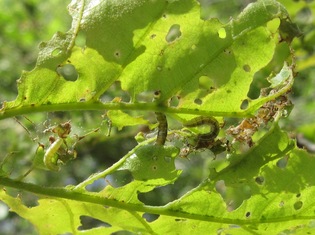 Winter Moth (Operophtera brumata) – Winter moth larvae are feeding on the leaves of oaks, apple, birch, blueberries, and other trees and shrubs. They are still tiny, but expect to see increased defoliation over the next two weeks. The little green inch worms will then string down on silk to spin cocoons in the soil below the trees. There they will stay until December when the moths emerge to mate and lay eggs. DO NOT MOVE soil, perennials, saplings, etc., from under or near winter moth infested trees. You will be moving winter moth with the soil/plant material. The cocoons look like dirt. Nurseries that sell perennials often keep the potted plants under trees to shade them from the sun. These pots need to be protected from infestation by winter moth larvae dropping into them over the next 2–3 weeks. Populations appear to be down from previous years. Winter moth is currently found along the coast from Kittery (York County) to Mount Desert Island (Hancock County).
Photo: Winter moth larvae (Maine Forest Service)
In related news, Charlene Donahue cooperated with the University of Maine on a winter moth study and the results were published in:
O’Donnell, K. and E. Groden. 2017. Variation in Captures of Adult Winter Moths (Operophtera brumata) In Coastal Maine Over Two Years. In Northeastern Naturalist Winter Ecology: Insights from Biology and History. 24(Special Issue 7):B72–B80.
Available on-line to Northeastern Naturalist subscribers.
|
Yellowheaded spruce sawfly (Pikonema alaskensis) – Yellowheaded spruce sawfly damage is common on young, open-grown spruce in Maine. The following excerpt from Minnesota DNR forest health specialist Brian Schwingle is hard to improve upon (From Minnesota DNR, our emphasis): “Yellowheaded spruce sawflies can seriously damage spruce seedlings and saplings, so I recommend controlling them if they caused problems the previous year. On ornamental spruce in your yard, spray young larvae less than 1/3-inch long off trees with a strong jet of water (and laugh evilly as you're doing so). Do this daily to keep them off the trees, starving them. In young plantations, spray young sawfly larvae with an insecticidal soap or horticultural oil if they are common. Young larvae are difficult to see, so begin scouting for them from late May to early June.”
Needle cast diseases of spruce are very common throughout Maine, especially in planted landscape trees. The two most common fungi causing needle cast are Stigmina lautii (Stigmina needle cast) and Rhizosphaera kalkoffii (Rhizosphaera needle cast). Although Colorado blue spruce seems to be most susceptible to infection, the diseases have also been noted causing severe symptoms on white spruce and both diseases have also been found in the forest environment in Maine. The spruce needle casts are also known to affect red spruce and Norway spruce, although Norway spruce is considered to be resistant to infection and noticeable needle loss is rare in that species.
Both needle cast fungi affect susceptible spruce trees in a very similar way (loss of second- and third-year needles) and the fungi even look similar growing in/on infected needles (rows of tiny black dots filling the stomata on the underside of needles; see figure). However, these fungi have different life cycles. Thus, accurate diseases diagnosis is a very important first step to management.
If needle cast infection is confirmed on a tree and the decision is made to treat the tree, there are several important things to consider and they are outlined in the following text.
Needles on at least the bottom half of the crown should be protected with fungicide containing the active ingredient ‘chlorothalonil’. A finer mist is best to assure that the green needles are thoroughly coated. Check the residual period (the time that the fungicide remains effective on the tree) of the product used to determine how frequently applications of the fungicide are needed to ensure there is not a lapse in protection. A typical residual period for protective fungicides used on conifers is 7 to 14 days (make sure to read and follow all label recommendations or hire a licensed applicator).
For Stigmina needle cast fungus the first treatment should be applied in early spring, since this fungus produces spores earlier – well before bud-break, infecting needles produced in the previous year (this year spore production was seen on infected needle samples collected already during the first week of May). Once fungicide treatment begins, it must be continued every two weeks (again depending on the residual period) until September. According to current knowledge about the Stigmina needle cast disease, this must be repeated every year to ensure needle retention (Stigmina needle cast disease has not been intensively studied).
If only the Rhizosphaera needle cast fungus is present on a tree, treatment should begin at the candle stage (when new growth is emerging and measures about 1 to 1.5 inches; see figure) and continue until the end of July. Treatment can be stopped after three or four years, as the infection cycle is typically effectively broken at this duration of treatment.
It is important to remember that fungicides labeled for control of spruce needle cast fungi are not curative and are only effective when applied as protectants before spores are released. The first year application cycle will protect the current year’s growth only and needles will not regrow on the portions of the tree that have already lost needles. Treatments applied in the second year will ensure retention of at least two years’ worth of needles; three years of treatment will ensure retention of three years’ worth of needles, and so on, with the eventual result of a fuller, healthier tree with a full complement of needles. Treating needle cast of spruce is a long-term process that can be frustrating, since it takes a few years of treatment before sufficient needle retention is achieved, making aesthetic improvements noticeable. This is often frustrating for tree owners and tree replacement with a needle-cast resistant species is worthy of consideration.
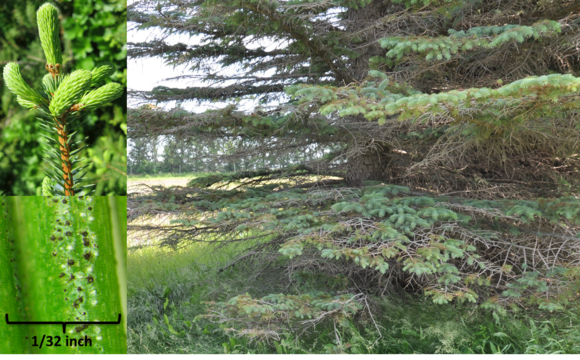 Photos (Above): (Upper left) Spruce needle emergence of about 1 to 1.5 inches, referred to as the ‘candle stage’. (Lower left) Close-up of spruce needle infected with Stigmina needle cast fungus. Note the tiny black spots growing out of the gas exchange pores (stomata). (Right) Fine branch dieback due to chronic infection and needle loss, reducing the aesthetic qualities of a spruce tree.
White pine needle diseases (Lecanosticta acicola, Lophophacidium dooksii, Bifusella linearis and others) – The yellowing, browning, and premature shedding of one-year-old needles of white pines appears to be beginning in the region, with affected trees exhibiting (in some cases heavy) needle drop any time between now and early July. Trees that have been severely damaged over several consecutive years may show dieback of lower branches and an overall “thin” crown appearance. Weakened trees are subject to additional damage from secondary insects and pathogens that are better able to take advantage of the chronically stressed trees.
NH Forest Health Workshop, Friday 07/14/2017, 8:30 AM–3:30 PM, Fox State Forest - 309 Center Road, Hillsborough NH 03244: All-day, “in the field” workshop at Fox Research and Demonstration Forest. Stations with unique sets of insects or diseases for hands-on examination and discussion with specialists. $45.00 - lunch provided, SAF Category 1 - 4.0 CFEs; NHPLP Certification - 8.0 CEUs.
Conditions Report No. 2, 2017
- On-line: http://maine.gov/dacf/mfs/publications/condition_reports.html
- DEPARTMENT OF AGRICULTURE CONSERVATION & FORESTRY
- Maine Forest Service - Forest Health and Monitoring
- Contributors: Aaron Bergdahl, Charlene Donahue, Allison Kanoti, Colleen Teerling
|